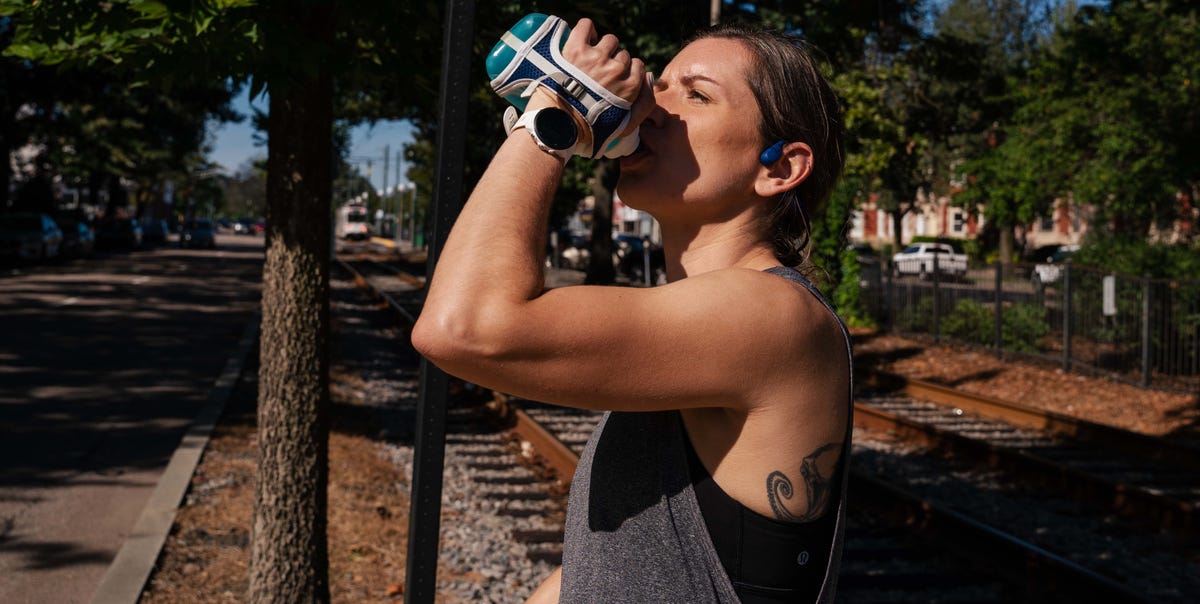Running in the summer sounds idyllic—sunshine, longer days, endless outdoor miles. But the reality can sometimes skew more toward scorching exposure, humidity that hits like a wall, and even earlier wakeup calls to beat the worst of the heat.
You may not be able to control the conditions, but you can better survive them by giving your fueling strategy a seasonal upgrade. Your body doesn’t just need more water, it needs fuel that helps it retain that water, regulate its temperature, and repair tissue damage so you can maintain performance. Here’s how to eat smart so you don’t bonk or bake.
Related Story1. Eat More Carbs
Distance runners need carbohydrates year-round, but as the weather warms up, increasing how much you eat can help you better acclimate to the heat. Runners whose energy intake was 70 percent carbs demonstrated faster time-trial performances after a six-day heat acclimation protocol, compared to runners whose energy intake was only 35 percent percent carbs in a 2025 study published in Medicine & Science in Sports & Exercise.
Glycogen (a.k.a. the body’s stored form of carbs) helps your body hang onto water, which is key when you’re sweating buckets. For every gram of glycogen your body stores, it also retains 3 to 4 grams of water, explains Alexa Rae Ardito, RDN, a registered dietitian nutritionist.
Heat is an extra form of stress during exercise, so your body has to work harder—meaning, use more energy—than it would in cooler weather to maintain the same pace. “Having enough carbs can help you feel less wiped out, make your run feel a little easier, and help you keep up your effort even when conditions are tough,” says Ardito.
Aim for 1 gram of carbohydrates per pound of bodyweight approximately two hours before a run, says Pamela Nisevich Bede, R.D., C.S.S.D., sports dietitian and global nutritionist for Lingo by Abbott. “This timing allows for adequate energy on hand during the workout and for carbohydrates to be digested, absorbed as glucose, and circulated or stored, so you’ll have steady or even increasing energy as you begin rather than starting the run as your glucose is still returning to baseline (which can feel like a dip or crash),” she explains.
Related Story2. Prioritize Foods With a High Water Content
The more you sweat, the more water you need. About 20 percent of your daily fluid demands should come from water-rich foods, according to the official recommendation from the National Academy of Sciences, Engineering, and Medicine (NASEM). Upping the amount of water-rich (and nutrient-dense) foods in your diet can be a sneaky way to stay hydrated. “Fruits and vegetables typically fit this bill, with melons, cucumbers, citrus, celery, tomatoes, leafy greens, bell pepper, and berries being top choices,” says Bede.
“These foods aren’t meant to replace the carbs your body needs for fuel, but they’re excellent additions to your regular meals and snacks to help support hydration and recovery,” adds Ardito.
Even better: Water-rich foods are easier to digest in the heat, which means less risk of midrun GI issues, and they tend to be rich in electrolytes like potassium and magnesium, which are lost in sweat and play a role in muscle health.
Related Story3. Make Sure You’re Increasing Electrolytes
When you sweat, you’re not just losing water, you’re losing electrolytes, which are essential minerals—like sodium, potassium, magnesium, and calcium—and help regulate fluid balance, support muscle and nerve function, and maintain blood pressure. “In hotter temps, runners lose more electrolytes through sweat and it’s important to replace those to help prevent cramping, dizziness, fatigue, and GI issues,” says Ardito.
Unfortunately, it’s easier to calculate your fluid losses than it is to figure out how many electrolytes you need. “Sweat rates can vary a lot from runner to runner, so there’s no one-size-fits-all number,” says Ardito. “A general starting point is around 500 to 700 milligrams of sodium per hour for runs longer than 60 minutes, but some runners, especially heavy or salty sweaters, may need closer to 1,000 milligrams per hour.”
New sweat-testing tech is making it easier to dial in your electrolyte needs, but if you’re not down to spend that kind of money, “I generally advise individuals to hydrate for runs lasting longer than 90 minutes with electrolyte beverages, as these drinks are designed to maintain fluid status and provide rehydration,” says Bede. “After a run, rehydrate until your urine returns to a light straw color (within two hours), prioritize sodium intake (sodium is the most common electrolyte lost in sweat), and refuel with water-rich foods.”
Related Story4. Amp Up Your Antioxidants
Hot summer miles double the stress on your body, as heat makes any effort harder.
“Heat exposure and exercise both increase oxidative stress,” says Ardito, which ramps up the production of free radicals—unstable molecules that can mess with your cells and contribute to inflammation, fatigue, and slower recovery.
You can combat that stress by eating foods with more antioxidants, which are molecules that help your body fight those damaging free radicals. “Antioxidant-rich foods like berries, cherries, leafy greens, beets, and tomatoes can help buffer this response and support recovery,” says Ardito. (Adding more of these foods to your diet is a great idea regardless of season, adds Bede.)
While there are a lot of trendy high-dose antioxidant supplements, “it’s best to focus on whole food sources—fruits, veggies, nuts, and whole grains—rather than high-dose antioxidant supplements, which can sometimes backfire by blunting the important signals your body needs to trigger training adaptations,” says Ardito.
Related Story5. Sip a Slushy Before You Run
Downing a slushy before a hot run isn’t just a treat, it’s a performance hack. The icy drink helps lower your core temperature before you start running, giving your body more time to perform before the heat catches up.
Swigging a slushy (whether it’s made from plain ice or a sports drink) 30 minutes before exercise can significantly decrease your core temperature and boost exercise performance, according to a 2023 review published in The International Journal of Exercise Science.
Related Story6. Refuel Right After
After a hot run, it’s normal for your appetite to take a hit. “That’s partly because your core body temperature is elevated and blood flow is still shifting,” says Ardito. Exercise actually diverts blood away from your gut to help cool your body.
But skipping recovery fuel isn’t doing you any favors: People who delayed their carbohydrate intake for three hours after a HIIT workout had a lower exercise capacity the next day compared to when they consumed carbs immediately postworkout—even though muscle glycogen levels were the same during both conditions, according to a small study of nine recreationally active men, published in September 2024 in Acta Physiologica.
“[After a workout] is the perfect time to recover and rehydrate with a protein shake or smoothie,” says Bede. The latter allows you to combine protein with electrolytes and antioxidant- and water-rich foods in a customizable way that’s easier to digest while your stomach is still settling. Just make sure to squeeze something in in the first 30 to 60 minutes postrun to kickstart your recovery!
Related Stories
Ashley Mateo is a writer, editor, and UESCA- and RRCA-certified running coach who has contributed to Runner’s World, Bicycling, Women’s Health, Health, Shape, Self, and more. She’ll go anywhere in the world once—even if it’s just for a good story. Also into: good pizza, good beer, and good photos.
